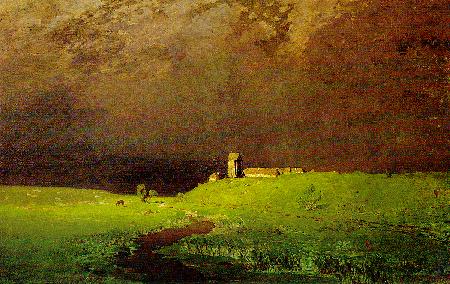
Oil on canvas, 102 x 159 cm. Tretiakov Gallery, Moscow.

 Arkhip Kuindzhi created this painting in 1879. His style, as seen
here, is elegant and mature in its synthesis of ideas and evocation of
mood. After the Rain is actually a good representative of Kuindzhi's
overall work, which was distinguished by "primary contrasts of colors"
and the painter's unique conception of "light as a concrete phenomenon"
and his attempt to "transmit [light's] fullness and density" (22). This
painting is also an interesting example of the art of the period; although
Kuindzhi was a member of the Wanderers (an artistic movement concerned
with realism as it pertained to social change), this painting is not typical
of most of the Wanderers' work. It represents Kuindzhi's "artistic psychology"
as very different from the other Wanderers of his day, and is perhaps one
of the best expressions of the painter's "lyrical, subjective interpretation
of life and art" (22). It was also of some influence in other painters
of the Russian landscape, including Isaac Levitan, who "plagiarized rather
freely" another work of Kuindzhi (24).
Arkhip Kuindzhi created this painting in 1879. His style, as seen
here, is elegant and mature in its synthesis of ideas and evocation of
mood. After the Rain is actually a good representative of Kuindzhi's
overall work, which was distinguished by "primary contrasts of colors"
and the painter's unique conception of "light as a concrete phenomenon"
and his attempt to "transmit [light's] fullness and density" (22). This
painting is also an interesting example of the art of the period; although
Kuindzhi was a member of the Wanderers (an artistic movement concerned
with realism as it pertained to social change), this painting is not typical
of most of the Wanderers' work. It represents Kuindzhi's "artistic psychology"
as very different from the other Wanderers of his day, and is perhaps one
of the best expressions of the painter's "lyrical, subjective interpretation
of life and art" (22). It was also of some influence in other painters
of the Russian landscape, including Isaac Levitan, who "plagiarized rather
freely" another work of Kuindzhi (24).
After the Rain, then, is both of historical and aesthetic interest to the modern viewer. The painting is beautiful, yes, but more importantly it successfully creates a mood that, inevitably, affects those who see the painting. The smell of rain lingers in the air and the feeling of refreshment and purity after a rainstorm is unmistakably present. Kuindzhi achieves these reactions in the viewer by a variety of methods, some of which include:
deep color contrast (darkness of the sky, brightness of the grass)
subject contrast (between the sky, whose fury has relaxed only moments before, and the peaceful pasture whose existence is dependent on rainstorms such as that which has just passed)
relaxed brushwork (contributing to tranquility and slightly" impressionistic" feel of the scene)
impression of luminescence created through the artist's technical skill
Kuindzhi harnessed each of these elements in order to create a painting that, instead of imitating a dry "realism," expressed with eloquence and agility the temporal moods of nature as observed by a true connoisseur of the Russian landscape. [C.B.]
[Source: Bowlt 1982].
